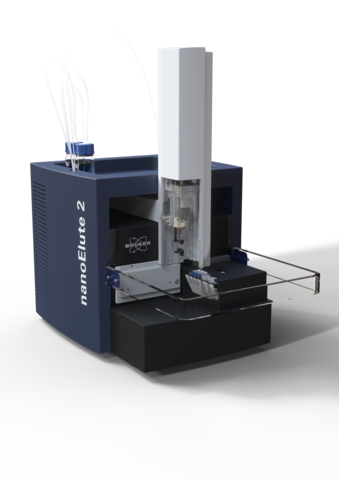Bruker Launches New nanoElute® 2 nano-LC For 4D-Proteomics, Advances Fluxomics Applications with MetaboScape® 2023 Software
Bruker Corporation (NASDAQ: BRKR) has launched the nanoElute® 2 nano-LC system and updated software for MetaboScape® and TASQ® at IMSC 2022. The new nanoElute® 2 enhances single-cell proteomics with improved chromatography performance and user interface. MetaboScape 2023 introduces advanced metabolic profiling features and quality assessment tools. The MALDI HiPLEX-IHC workflow enables multiplex imaging for protein targets, enhancing spatial localization. These innovations support research in proteomics and protein interactions, significantly advancing capabilities in the scientific community.
- Launch of nanoElute® 2 enhances single-cell proteomics capabilities.
- MetaboScape 2023 introduces improved metabolic profiling and data quality assessment tools.
- MALDI HiPLEX-IHC workflow enables multiplex imaging of protein targets, enhancing research capabilities.
- None.
Insights
Analyzing...
- New nanoElute 2 features nano-LC advances, supports automated single cell sample preparation from label-free ProteoCHIP on CellenONE platform
- MetaboScape® 2023 advances fluxomics applications and ion mobility offset mass aligned (‘MOMA’) events for high-throughput 4D-Metabolomics
- Advances in MALDI HiPLEX-IHC™ workflows, and in PaSER™ on-the-fly intelligent acquisition software for 4D-Metaproteomics
MAASTRICHT,

The nanoElute® 2, a high-performance nanoflow liquid chromatography system with an intuitive and flexible user interface, covering a broad range of applications from single cell to high throughput routine proteomics (Photo: Business Wire)
The next-generation nanoElute® 2 combines outstanding nano-LC chromatography performance with hardened high-pressure switching valves, and finger-tight torque-limiting capillaries for leak-free zero dead volume connections, without the risk of overtightening or damaging capillaries. The nanoElute 2 features a further improved nano-LC pump design, and an intuitive and flexible user interface covering a broad range of applications from single-cell proteomics to plasma proteomics. The nanoElute 2 now also supports the label-free ProteoCHIP® for the CellenONE platform for high-sensitivity single cell proteomics.
Dr.
The latest MetaboScape 2023 release provides streamlined collision cross section (CCS)-enabled metabolic profiling and annotation workflows covering 4D timsTOF data acquisition to highest confidence annotations for lipids and metabolites. New features include improved 4D peak detection and integration, accelerated processing, and smart merging of positive and negative ion data. Powerful automated prediction of CCS values from chemical structures in spectral libraries leverages the accurate CCS values measured on the timsTOF.
In addition, to support the metabolomics community focus on quality, MetaboScape 2023 now offers better means for data quality assessment in large scale studies, while TASQ 2023 extends target screening and quantitation by CCS-enabled
Professor Nils Faergeman,
At IMSC, Buker also showcases the new MALDI HiPLEX-IHC workflow for multiplex imaging of protein targets. MALDI HiPLEX-IHC combines Bruker’s IntelliSlides® automated MALDI workflow with AmberGen’s Miralys antibody-based photocleavable mass tags for spatial localization of target proteins across tissue sections. Key advantages of the workflow include whole slide field-of-view and multiplexing capability of tens to over a hundred protein targets from FFPE or fresh frozen tissue sections, as well as multiomics capability to overlay metabolite, lipid and glycan mass spec images with protein targets from the same section.
Dr.
At IMSC, Bruker also further advances its bioinformatics proteomics real-time search capabilities using PaSER™. Intelligent instrument control leveraging the 4th dimension of large-scale accurate CCS data promises significantly greater insights, from post-translational modifications of the epiproteome, to substoichiometric analytes in targeted approaches.
Dr. Mathieu Lavallée-Adam, Associate Professor at
About
Bruker is enabling scientists to make breakthrough discoveries and develop new applications that improve the quality of human life. Bruker’s high performance scientific instruments and high value analytical and diagnostic solutions enable scientists to explore life and materials at molecular, cellular, and microscopic levels. In close cooperation with our customers, Bruker is enabling innovation, improved productivity, and customer success in life science molecular and cell biology research, in applied and pharma applications, in microscopy and nanoanalysis, as well as in industrial applications. Bruker offers differentiated, high-value life science and diagnostics systems and solutions in preclinical imaging, clinical phenomics research, proteomics and multiomics, spatial and single-cell biology, functional structural and condensate biology, as well as in clinical microbiology and molecular diagnostics. Please visit www.bruker.com.
View source version on businesswire.com: https://www.businesswire.com/news/home/20220829005210/en/
Media
T: +49 (421) 2205-2843
E: petra.scheffer@bruker.com
Investor Relations
Sr. Director Investor Relations &
T: +1 (978) 663–3660, ext. 1479
E: Investor.Relations@bruker.com
Source:







